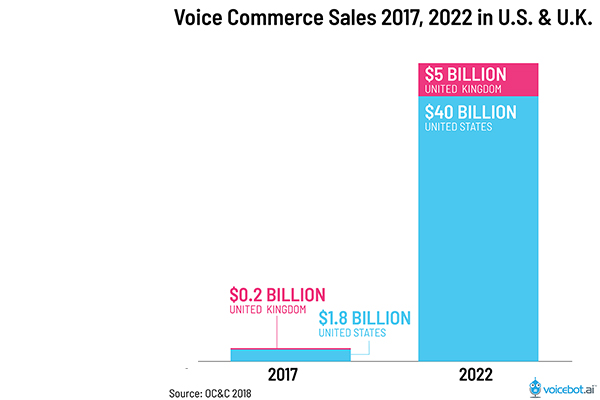Voice Shopping to Reach $40 Billion in U.S. and $5 Billion in UK by 2022
OC&C Strategy Consultants announced a report suggesting that voice commerce was a $1.8 billion retail segment in the U.S. in 2017 and $200 million in the U.K. The consultancy projects those numbers to rise to $40 billion in the U.S. and $5 billion in the U.K. by the end of 2022. Annual spending by voice shoppers today is $300 in the U.S. and £150 in the U.K. In addition, the report suggests that household adoption of smart speakers today is 13% and will grow to 55% by 2022. For the U.K., the figures are 10% today growing to 48% in 2022.
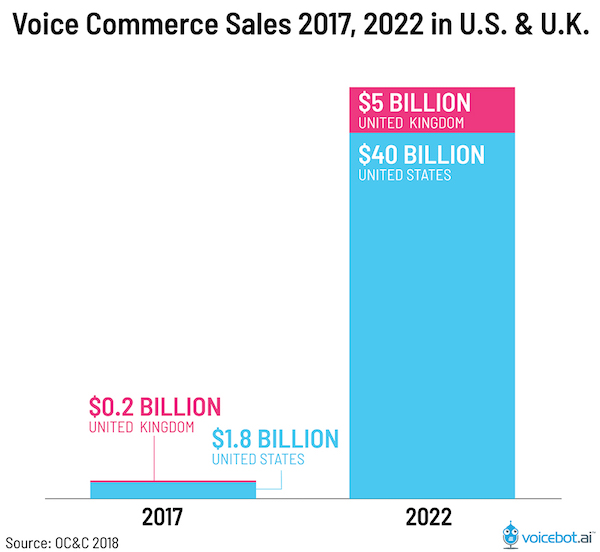
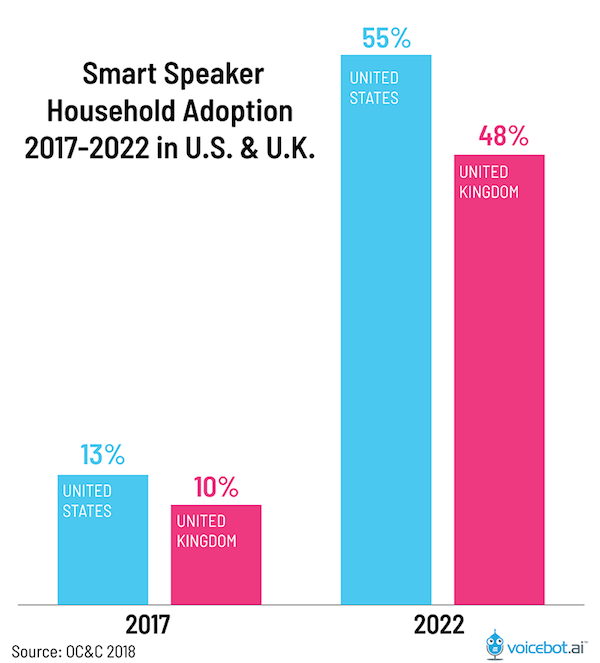
It is worth noting OC&C’s finding that 36% of smart speaker owners use the devices for shopping is considerably higher than the results reported by Edison Research and NPR. The Edison report which included data taken in the same time period in the U.S. found that only 22% of the population had tried voice commerce. This figure tracks closely with Voicebot’s own market research which found that 23% had used their smart speaker to make a purchase at least once. The variance may be influenced by the fact that the U.K. is also included in the OC&C data, the consumer survey technique may have differed and there were variances in how the questions were asked. However, whether it is one-in-five or one-in-three smart speaker owners that have tried voice commerce, it is a big number and growing.
Voice Shopping Households More Likely to be Young, Affluent and Have Children
The report also suggests that voice shopping household demographics skew toward the young and affluent with children. While 29% of the general population falls in the 18-29 age group and they represent 28% of Amazon Prime members, this group accounts for 36% of voice shopping. In fact, the 18-39 age group accounts for a full 70% of voice shopping according to the study versus 40% overall.
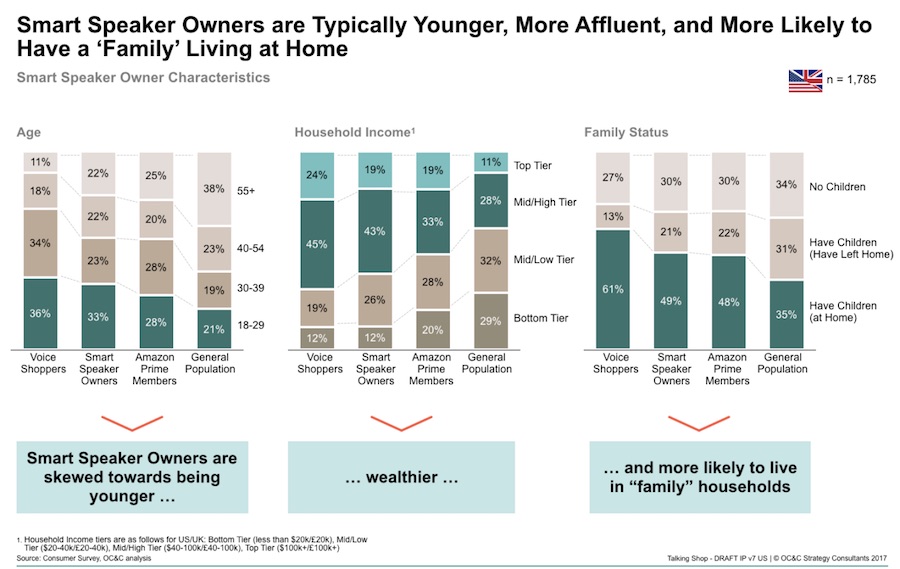
In addition, about 11% of the general population is categorized by OC&C as being in the top tier of households earning more than $100,000 annually, but this group accounts for 24% of voice shopping. And, 61% of voice shoppers report having children at home compared to 35% of the total populations in the U.S. and U.K. While the report suggests voice commerce accounts for less than 1% of online spending today, it is comprised of a consumer segment coveted by retailers and consumer goods manufacturers.
Voice Shopping is Popular for Grocery, Entertainment and Electronics
The breakdown of product categories for voice shopping today in OC&C’s results is also interesting. Grocery fits the model of reordering known products that that relatively low and stable price points. This leads the list of most common voice shopping categories. Entertainment can also fall into the reordering category and at least fits the low price point segment. The third ranked category, electronics, does not fit the low-cost, consistent pricing or repeat purchase models. Despite lacking those characteristics, it was listed at 17%, just slightly behind grocery at 20% and entertainment at 19%.
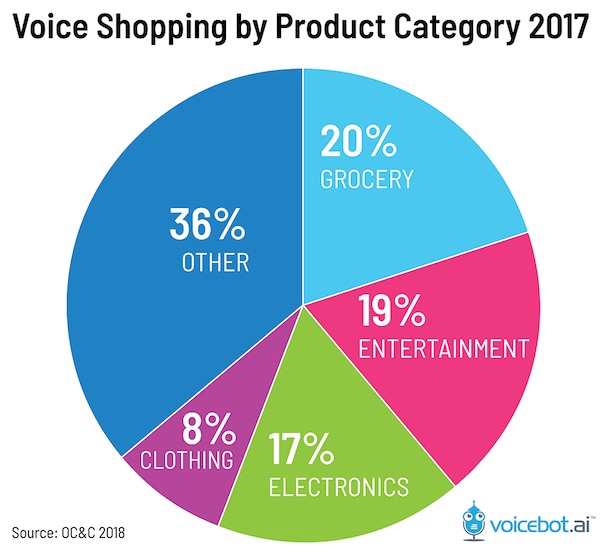
You might be able to explain the high ranking for electronics based on demographics. Voice shoppers are more likely to be electronics aficionados by the mere fact that they own a smart speaker. That interest and comfort level with the product category could lead them to voice purchases even for items that are not consumables. However, the fourth item breaks this model even further. Clothing was considerably behind the others at 8%, but is presumed to be more of an experience buy with higher variability in personal fit and a category where visuals are highly important. This tells us that voice commerce has the potential to reach across a wider set of product categories that many analysts previously predicted.
Amazon Asserts Power of Suggestion in Voice Shopping
The report goes on to conclude that Amazon wields a tremendous amount of power in the voice shopping process.
“Amazon has a firm hold over consumers’ buying decisions, with 85% of consumers selecting the products Amazon suggests. Currently, 45% of grocery orders replace existing store or online purchases, the vast majority are made through Amazon Fresh.”
This is where the power of suggestion and voice assistant agency will play such a critical role in voice commerce. Nearly 2 in 5 consumers trust the “personalized” recommendations by voice assistants today. That means many consumers will just accept the suggestion and complete the transaction without comparison shopping. Voice commerce is less about browsing than about transactions. OC&C associate partner John Franklin commented:
Voice commerce represents the next major disruption in the retail industry, and just as e-commerce and mobile commerce changed the retail landscape, shopping through smart speaker promises to do the same.
The biggest issue for retailers and consumer products companies today is that they do not have their product content and shopping processes voice enabled. Companies other than Amazon have jumped in to attempt to fill the various gaps. Alpine AI is looking to help consumer goods companies position themselves for the voice-enabled path-to-purchase, but does not currently extend into transactions. Voysis does enable transactions and focuses on helping retailers offer voice shopping experiences in mobile apps beyond the smart speaker and Amazon’s grasp. Given voice commerce’s expected growth rate, you can expect to see even more vendors enter the space as product sellers increasingly look to position themselves for voice shopping success.


